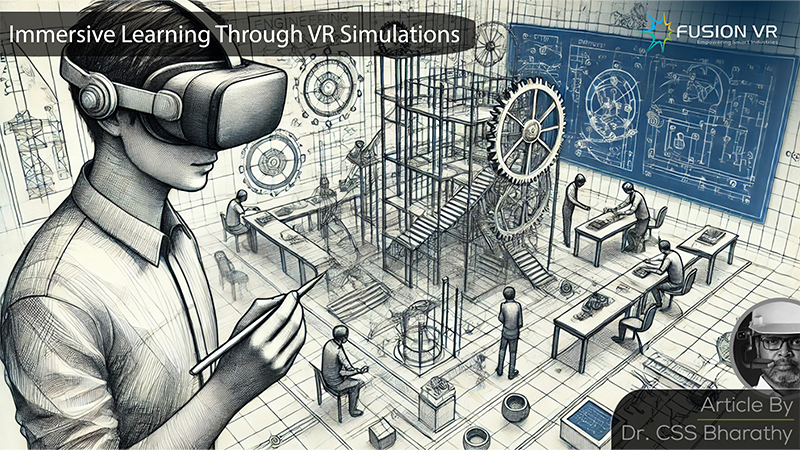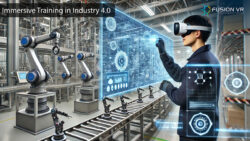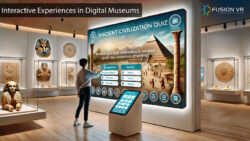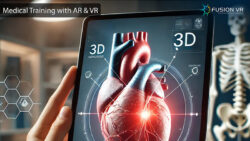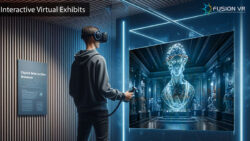Virtual Reality (VR) is among the leading and most impressive new technologies available today, particularly in education. One of the major advantages of VR is that it creates active experiential learning, which is tremendous for teachers, students, and institutions globally. As the world of education changes and morphs within the digital sphere, VR simulations will only advance larger and larger in teaching and beyond. In this blog, we will discuss the top five benefits of virtual reality simulations in education and explore how students can utilize VR through specialized virtual reality courses, development opportunities, and certifications.
Enhanced Engagement and Immersive Learning
The traditional classroom primarily utilizes passive learning strategies built around reading, lectures, and videos. There is no difficulty with these modalities; however, they are generally passive and take away from the outcomes of students’ deep learning to make a connection with the material. This is the distinct advantage of VR simulations compared to all other experiential learning programs.
In a VR environment, students can discover simulated realistic environments where they can interact with them in real-time and feel as if they exist physically. Whether walking us through a historical moment in history, going to the ocean floor, or doing a complex surgical procedure, students have the chance for hands-on learning in a simulation that feels real. This level of interaction allows for more retention and understanding.
For instance, Fusion VR’s Industry-Academic Alliance Program brings these experiences directly to students, integrating VR technologies into academic curricula. These immersive experiences foster curiosity, excitement, and motivation to learn, making difficult subjects more accessible and engaging.
Virtual Reality Courses and Certifications: Now many institutions offer specific courses and certifications in VR to allow students to learn virtual reality and its educational applications. Such programs start to build the foundation of skills and help students explore deeper possibilities of VR.
Safe and Risk-Free Learning Environment
One of the virtual reality simulation’s greatest strengths is that it can train people in a completely risk-free, controlled environment where events connected to outcomes have no real-life consequences. This is a very important aspect in fields that can incur substantial monetary, safety, or even life risks with mistakes, such as medical, engineering, or flight school. An individual within a fully immersive virtual reality environment can practice the same, arduous procedure many times and receive feedback on their performance, which should improve overall performance before engaging in the real-world activity that is expected in some relevant unique context. The same could apply to a medical student who simulates a surgery in a realistic training environment as opposed to using cadavers or real patients for training. Students studying engineering can actually build things or check structures in a simulated environment, before even taking the project to scale.
VR Developer Opportunities: As the various industries continue to adopt and integrate virtual reality into the learning and new employment experiences, the demand for VR developers will continue to increase. Those students who can develop these realistic (safe and controlled) environments will be highly sought after in both academic and professional practice. Programs designed to teach students the basics and advanced causes of VR development could offer a great benefit for students.
Personalized Learning Experiences
The majority of the learning needs will not be fulfilled by any one single educational practice; however, the VR simulations enriched with customization gives a possibility of the educators to create a more individual learning environment in which children can learn at their own speed or at the same time and which they can similar or different interactions, which lead them to exercises directed to solve particular problems they are confronted with (they might be caused due to)
Besides, the VR simulations enable the learners to return to the situations that are the most difficult for them as many times as they want and variations only to those that are required. Thus, students have the option to master a concept being side by side with their classmates.
By adding virtual reality technology, educational institutions can customize the curriculum to the learning demands of differently gifted students. The fact that the technology is very adaptable is the most important driving force usually given for VR training at all levels whether for academic or corporate purposes.
Virtual Reality: A Tool for Personal Development: VR makes learning for students a very personal affair by providing them opportunities to take personal responsibility through enrolling in VR courses and certification programs where they get engaged into the exploration of new interests and mastering new skills. They have everything from software tools mastering to VR content creating, through method, and also students find that they themselves are to a great extent responsible for their high-quality learning experiences.
Breaking Geographic Barriers
Geography has always been a dry subject and students couldn’t avail any of the information and data by actually visiting those places. But VR technology now creates new ways of learning, even letting students visit remote locations, do some actual activities there or meet other students from around the world. Research centres/natural location on the opposite side of the globe being off limits because to travel costs will be accessible. And using VR they can also go back in time or visit another culture.
VR Education for All: A VR Certification Program to Support Students and Teachers. This program will explore how educators can utilize virtual reality to modify their teaching methods, addressing the phenomenon of reduced attention spans in today’s generation.
Bridging the Gap between Theory and Practice
The application of VR simulations in the training program will give the trainees a first-hand, interactive experience with the theoretical data in a practical setting. In particular, this preliminary in STEM fields which define the standard terms in an abstract way creates a problem that this technology can solve. Without practical observation and without direct visual feedback from the experiment, these concepts sink in the minds of students and never come out. With the help of the simulated reality, the apprentices do various things to solve problems with the constants, the management of the variables is done, and the effects are seen in real-time.
Physics students are one example who can run experiments with a virtual device that is complex, or else chemistry students can work with the systems in 3-d to make and break the molecules, therefore, their material becomes much clearer for them. The association between theory and practice significantly enriches learning and makes it more relevant to the real-world.
VR Development Courses and Certification Programs: Students looking to bridge the gap between theory and practice in their own fields can benefit from VR development courses. These programs equip learners with the tools to create simulations that enhance experiential learning, offering both educators and businesses the means to create interactive training environments.
Conclusion: Unlocking Future Potential
The use of VR simulations in schooling is a long way from a passing trend it’s a glimpse into the future of mastering. By supplying immersive, safe, and personalized reviews, digital truth is breaking down limitations and reworking training at every stage. With the growing call for VR developers, those who engage with VR courses, VR training applications, and certification applications are positioning themselves at the vanguard of this revolution.
Fusion VR’s Industry Academic Alliance Program exemplifies the kind of ahead questioning collaboration that brings VR generation into lecture rooms, presenting students with the tools and experiences they want to succeed in an increasingly digital world. More schools are getting into this cool tech, and it’s going to change the way we learn big time.
By mixing VR into learning, we’re not just teaching kids now we’re setting up the brainy folks of the future.

